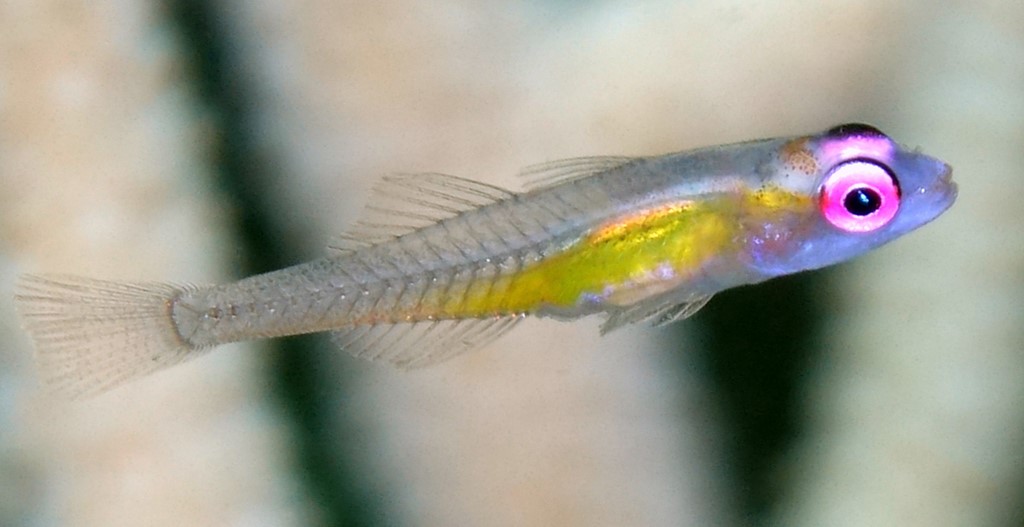BRYANINOPS NATANS - (LARSON, 1985)
Picture courtesy of: Alain Daoulas
Gobie à œil rouge, Gobie nain à œil rouge, Gobie nain à œil mauve, Gobie nain voltigeur, Purple-eye goby, Redeye goby, Hovering goby, Purple-eyed goby, Purple-eyed coral-goby, Hovering whipgoby, Violettaugen-Zwerggrundel, Akame-haze, アカメハゼ, 漂游珊瑚鰕虎魚,
Description
Dorsal spines (total): 7; Second dorsal fin spine: 1, dorsal soft rays (total): 7-9 (usually: 8); Anal spine: 1; Anal soft rays: 8-9 (usually: 9); Pectoral fin rays: 14-17 all or most rays unbranched; Transverse rows of scales backwards: 1-6; Scales on body extending forward at most to below interdorsal space, the longitudinal scale series: 19-40 (mean count 31); Body moderately elongate and compressed; Body depth at origin of anal fin: 16-25 % in SL; Snout usually shorter than orbit diameter. Head subcylindrical, Eyes large, lateral; Gill opening extending anteriorly well beyond a vertical through posterior margin of preopercle; Anterior margin of tongue trilobed; Canine tooth present on side of lower jaw. Pelvic fins united medially; Frenum present; Skin around pelvic-fin spine thickened, forming a lobe-like appearance; Caudal fin truncate. Scales ctenoid; Head, predorsal region, pectoral fin base and belly naked. Sensory canals and pores present on head; Longitudinal pattern of sensory papillae on cheek. Max. length: 2.5 cm TL. Depth range: 6 - 30 m.
Description
Dorsal spines (total): 7; Second dorsal fin spine: 1, dorsal soft rays (total): 7-9 (usually: 8); Anal spine: 1; Anal soft rays: 8-9 (usually: 9); Pectoral fin rays: 14-17 all or most rays unbranched; Transverse rows of scales backwards: 1-6; Scales on body extending forward at most to below interdorsal space, the longitudinal scale series: 19-40 (mean count 31); Body moderately elongate and compressed; Body depth at origin of anal fin: 16-25 % in SL; Snout usually shorter than orbit diameter. Head subcylindrical, Eyes large, lateral; Gill opening extending anteriorly well beyond a vertical through posterior margin of preopercle; Anterior margin of tongue trilobed; Canine tooth present on side of lower jaw. Pelvic fins united medially; Frenum present; Skin around pelvic-fin spine thickened, forming a lobe-like appearance; Caudal fin truncate. Scales ctenoid; Head, predorsal region, pectoral fin base and belly naked. Sensory canals and pores present on head; Longitudinal pattern of sensory papillae on cheek. Max. length: 2.5 cm TL. Depth range: 6 - 30 m.
Color
Head, body and fins transparent when alive, with a posteriorly-narrowing yellow band from gill chamber to ventral half of caudal peduncle through belly; Distinctive violet-red eyes.
Etymology
Bryaninops: from the former similar or related genus Bryanina now, Sicyopterus + from Ancient Greek, óps = eye, face, appearance.
natans: from Latin, natāns = swimming, floating. Referring to its hovering behavior, in contrast to the clinging, cryptic habits of other congeners.
Original description: Bryaninops natans Larson, 1985 - Type locality: Lizard Island lagoon, off eastern point of Palfrey Island, Great Barrier Reef, Australia, depth 6 meters.
Distribution
Red Sea; Indo-West Pacific: Persian Gulf, Seychelles, Madagascar, Maldives and Chagos Archipelago (British Indian Ocean Territory), east to Marshall Islands and Cook Islands, north to southern Japan, south to Queensland (Australia), New Caledonia and Tonga.
Biology
Hovers in groups above branches of certain Acropora corals in shallow lagoon reefs. Benthic spawner. Feed on zooplankton.
Last update: 25, May 2024
Head, body and fins transparent when alive, with a posteriorly-narrowing yellow band from gill chamber to ventral half of caudal peduncle through belly; Distinctive violet-red eyes.
Etymology
Bryaninops: from the former similar or related genus Bryanina now, Sicyopterus + from Ancient Greek, óps = eye, face, appearance.
natans: from Latin, natāns = swimming, floating. Referring to its hovering behavior, in contrast to the clinging, cryptic habits of other congeners.
Original description: Bryaninops natans Larson, 1985 - Type locality: Lizard Island lagoon, off eastern point of Palfrey Island, Great Barrier Reef, Australia, depth 6 meters.
Distribution
Red Sea; Indo-West Pacific: Persian Gulf, Seychelles, Madagascar, Maldives and Chagos Archipelago (British Indian Ocean Territory), east to Marshall Islands and Cook Islands, north to southern Japan, south to Queensland (Australia), New Caledonia and Tonga.
Biology
Hovers in groups above branches of certain Acropora corals in shallow lagoon reefs. Benthic spawner. Feed on zooplankton.
Last update: 25, May 2024
